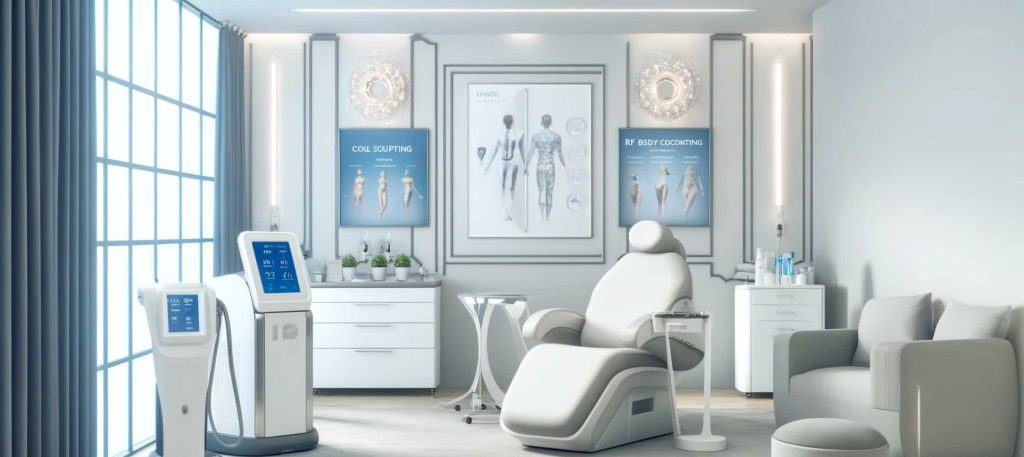|
Getting your Trinity Audio player ready...
|

Have you ever looked in the mirror and wished you could easily sculpt your body into the shape you’ve always wanted?
In the realm of cosmetic treatments, two non-surgical heroes are making waves for those looking to say goodbye to stubborn fat: CoolSculpting and Radio Frequency (RF) body contouring.
Each has its unique method and benefits, but how do you decide which is right for you? Let’s dive into the cool, sometimes literally, world of modern body sculpting.
What is CoolSculpting?
CoolSculpting, scientifically known as cryolipolysis, offers a chilly path to a slimmer you. This FDA-approved procedure eliminates stubborn fat by freezing the fat cells beneath the skin without any cuts or needles. Here’s how it works:
- Targeted Fat Freezing: CoolSculpting applies controlled cooling to pinchable fat areas, effectively freezing and killing the fat cells.
- Non-Invasive: There are no incisions or anesthetics required, making it a go-to for those wary of surgery.
- Effectiveness: Generally, each session results in a noticeable 20-25% fat reduction in the treated areas. Full results typically emerge within two to six months as the body naturally processes and eliminates the dead fat cells.
CoolSculpting is particularly adept at refining areas like the abdomen, thighs, and under the chin. Imagine targeting those tricky spots with a method designed for precision and minimal discomfort.
What is Radio Frequency Body Contouring?
While CoolSculpting takes a cold approach, Radio Frequency (RF) body contouring turns up the heat. Using RF energy, this technique heats the fat cells to a temperature that causes them to be damaged and eventually absorbed by the body. Here’s what sets RF apart:
- Skin Tightening: As the RF energy warms the deep layers of skin, it also promotes collagen and elastin production, leading to tighter, more youthful-looking skin.
- Versatility: RF is not just about fat reduction; it’s equally effective in improving skin texture and firmness across treated areas.
- Continuous Improvement: Post-treatment, the skin continues to firm up and improve in appearance over several weeks, with some patients seeing ongoing enhancements for months.
RF treatments are often recommended for larger or more diffuse fat deposits and are particularly effective in areas with mild to moderate skin laxity. Whether it’s the belly, thighs, or even the face, RF can provide a more comprehensive aesthetic enhancement by addressing both fat and skin quality.
Comparative Analysis: CoolSculpting vs. Radio Frequency Body Contouring
When deciding between CoolSculpting and Radio Frequency (RF) body contouring, understanding the core differences in their approaches can guide you to the best choice for your body sculpting goals:
- Methodology: CoolSculpting freezes fat cells, a process called cryolipolysis, which leads to their natural elimination from the body. In contrast, RF body contouring uses heat to damage fat cells and simultaneously tighten the skin through increased collagen production.
- Treatment Areas and Suitability: CoolSculpting is particularly effective for smaller, more defined areas where fat is pinchable—think under the chin, love handles, and smaller belly fat pads. RF, with its skin tightening benefits, might be the better choice for larger areas or for patients concerned about skin laxity as well as fat reduction.
- Session Information: CoolSculpting generally requires fewer sessions. One to two sessions might be sufficient for noticeable results. RF treatments might require multiple sessions (often weekly) over a period to achieve optimal outcomes.
Pros and Cons of Each Treatment
CoolSculpting:
- Pros:
- Targeted Fat Reduction: It is highly effective at targeting and reducing fat in specific areas.
- Minimal Downtime: As a non-invasive procedure, it allows patients to return to daily activities immediately after treatment.
- Cons:
- Sensations During Treatment: Some patients report discomfort due to the intense cold and suction of the applicator.
- Rare Side Effects: In very rare cases, a paradoxical adipose hyperplasia can occur, where the treated area increases in size instead of decreasing (Glow Luxe SkinCare & Medispa).
Radio Frequency Body Contouring:
- Pros:
- Skin Tightening: It not only reduces fat but also improves skin texture and tightness, making it ideal for areas with mild to moderate skin laxity.
- Wider Treatment Scope: Can be used on larger areas and is effective against cellulite.
- Cons:
- Multiple Sessions Required: Typically, many sessions are needed, spread out over weeks, to achieve significant results.
- Gradual Results: The results can be less immediately visible compared to the more dramatic fat reduction seen with CoolSculpting (Rejuveyourbody).
Patient Considerations: Which Treatment is Best for You?
Choosing between CoolSculpting and RF body contouring largely depends on individual needs and conditions:
- Personal Goals: If your main concern is reducing small, stubborn areas of fat, CoolSculpting might be the way to go. If you’re looking to address both fat and skin laxity—particularly over larger areas—RF could be more beneficial.
- Time and Budget Constraints: Consider how many sessions you are willing to commit to, and what your budget can accommodate. CoolSculpting, while potentially more expensive per session, usually requires fewer sessions than RF.
- Physical Eligibility: Not everyone is a candidate for these procedures. Those with certain medical conditions may need to consider other options.
In a Nutshell
Both CoolSculpting and RF body contouring offer effective solutions for non-surgical fat reduction and body sculpting. Your choice will depend on specific body concerns, desired results, and personal preferences.
Remember, the best way to decide which treatment will meet your needs is to consult with a qualified professional who can offer personalized advice based on your body type and aesthetic goals.
- Debunking Myths About Storage Body Fat - May 2, 2024
- Is Fiji Water Good for You – Health and Environmental Guide - April 22, 2024
- Is Sparkling Ice Good for You? Health Insights Revealed - April 22, 2024
